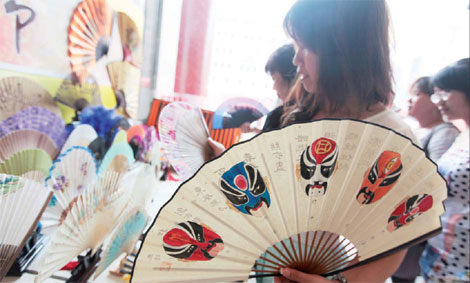Fans of the fan
Updated: 2011-11-18 07:44
By Liu Lu (China Daily)
|
|||||||||
|
The demand for folding fans in China is rising with decorated varieties the most popular. Provided to China Daily |
Traditional Chinese ornament taking pride and place in the home
The most eye-catching decoration in the living room of 77-year-old retiree Hou Shangzhu's house is not an eye-catching ink painting or framed family picture. It is a huge 4-meter folding fan hanging on the wall. The fan is light yellow in color and features beautiful Chinese calligraphy, the lines of a Tang poem. Hou says the fan has been on display for more than a decade and is one of his favorite things.
"Fans have long been an integral part of Chinese culture, it is a beautiful craft that represents auspicious times and good fortune," says Hou, explaining that the Chinese pronunciation of fan (shanzi) is similar to that of goodness (shanliang).
Hou says some Chinese believe that by hanging them on walls, the fans can dispel evil spirits and protect the family because of their good fengshui.
But he says the delicate items have always been valued from an aesthetic point of view and their home dcor function is fast becoming a new trend.
Fan manufacturers agree. They says the Chinese have always been major fans of the fan.
Liu Li, manager of the Beijing Tao Yuan Ji Craft Fan Co, Ltd, the largest fan maker in North China, says every aspect of the fan needs to be evaluated when appreciating its creation.
Li says the materials used, the quality of the paper used to cover the face, and even the nails used to hold the fan together, are all considered important. But perhaps the most significant aspect of creation, is the quality of pattern, painting or calligraphy featured.
"Over time, hand-held Chinese fans were integrated with Chinese paintings and calligraphy so that they were developed into a handicraft and a special art form in China," Liu says.
He says drawing or writing on these items is no easy task because the fan is narrow at the bottom and broad at the top.
"Therefore, painting on fans was usually more expensive than painting on other common materials," he says.
"Fans that included a famous artist's paintings or calligraphy were highly prized possessions."
Liu says as the number of skilled craftsmen has become fewer, some well-made fans have become sought-after collectibles.
"A beautifully crafted fan made of fine materials can be sold for hundreds of thousands of yuan. The artworks of well-known artists can be even more expensive at auctions."
Chinese fans have a long history. Tradition holds that King Wu of the Zhou Dynasty in the 11th century BC invented the Chinese hand-held fan, which is believed evolved from the umbrellas that were fixed to the top of carriages. The oldest Chinese hand-held fan was uncovered in Hubei province in 1982 and dates back about 2,300 years ago to the Warring States period (475-221 BC).
Chinese hand-held fans come in various styles and are made with different materials, including bamboo, paper, bone, feather, ivory, and silk. Industry experts say the value of a fan is not judged by their function, but by their beauty. "The main allure of the Chinese fan today is its value as a collector's item," says Liu.
He says Chinese fans have also played an important role as cultural "emissaries" across the world, especially in Europe in the late 17th century.
"Thanks to the growing trade, large numbers of painted fans were exported from China to Europe and became very fashionable," Liu says.
"Unlike the Chinese, people in Europe, especially members of royal families, liked the fans made from materials such as silk and lace and they wanted oil paintings drawn on them."
Another difference was that a majority of European users were women where as in China, men used fans as much as women.
In 2008 exports to Europe accounted for almost 30 percent of Liu's company's sales but because of the economic recession, there has been a sales decline.
However, overall business has not been affected because domestic demand keeps rising, he says. And one of his major customers is a Chinese tourist icon.
Liu is the biggest supplier of souvenir folding fans to the Palace Museum, and has also provided fans for the G20 finance ministers and other visiting VIPs.
Because of the scarcity of raw materials, demand for some wooden fans, particularly those made of sandalwood, has risen.
According to Sun Yaowen, manager of Suzhou Sandalwood Fan Company, the most outstanding characteristic of a sandalwood fan is the subtle fragrance emitted from the wood.
However, due to rapidly rising prices of raw materials, these fans are a luxury.
Sun says sandalwood has risen from 160,000 yuan ($25,216, 18,688 euros) a ton in 1990s to its current price of 7.2 million yuan a ton.
He says the complex carved patterns on the delicate sandalwood also contribute to the value. "We have to use the limited resources to produce the finest products," he says.
Sun's factory makes more than 200 varieties of fans and there is a huge demand for sandalwood fans from collectors who see them as a way of investment.
In 2006 sandalwood fans made by his factory, were put on the State-level intangible cultural heritage list.












